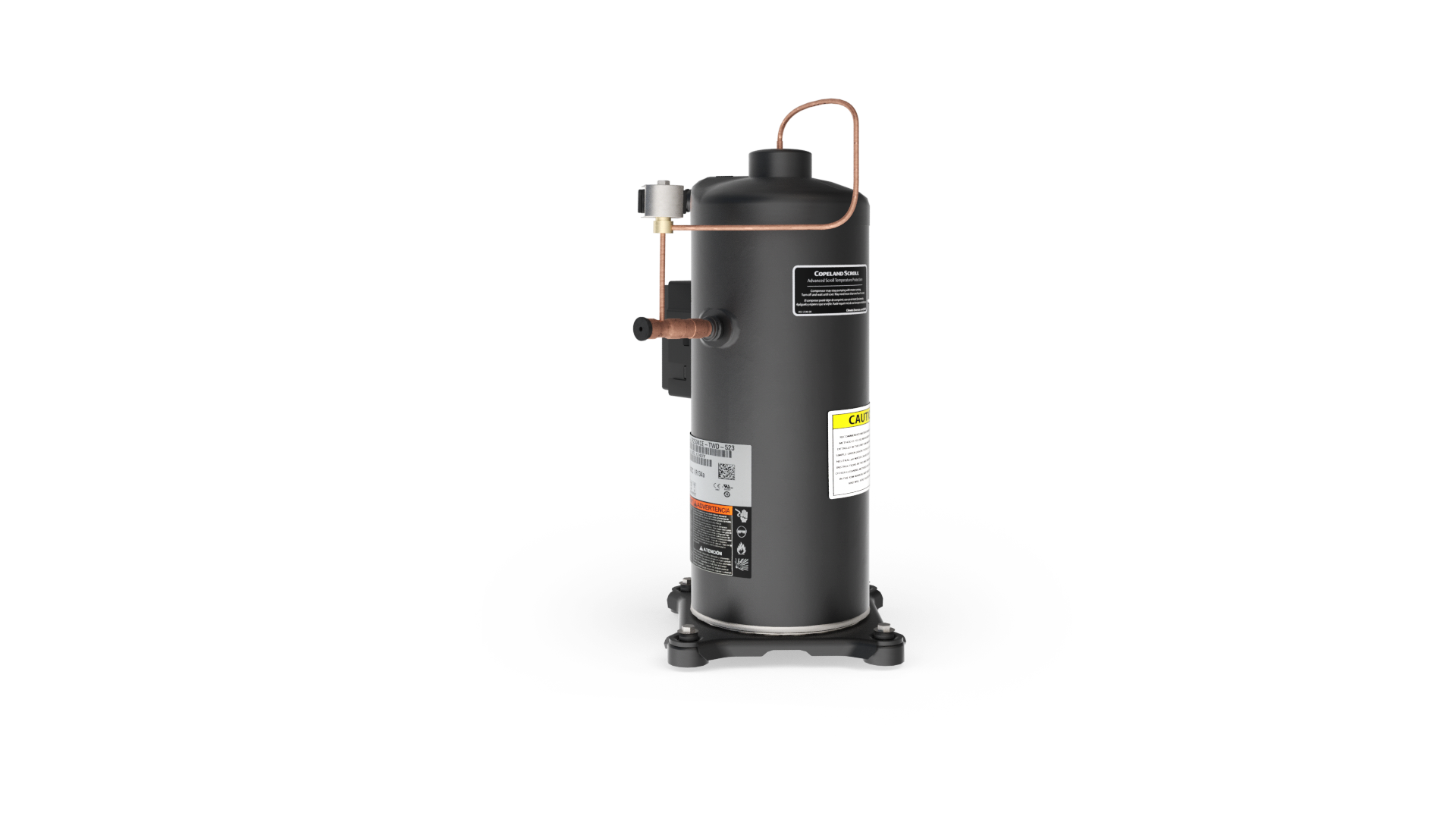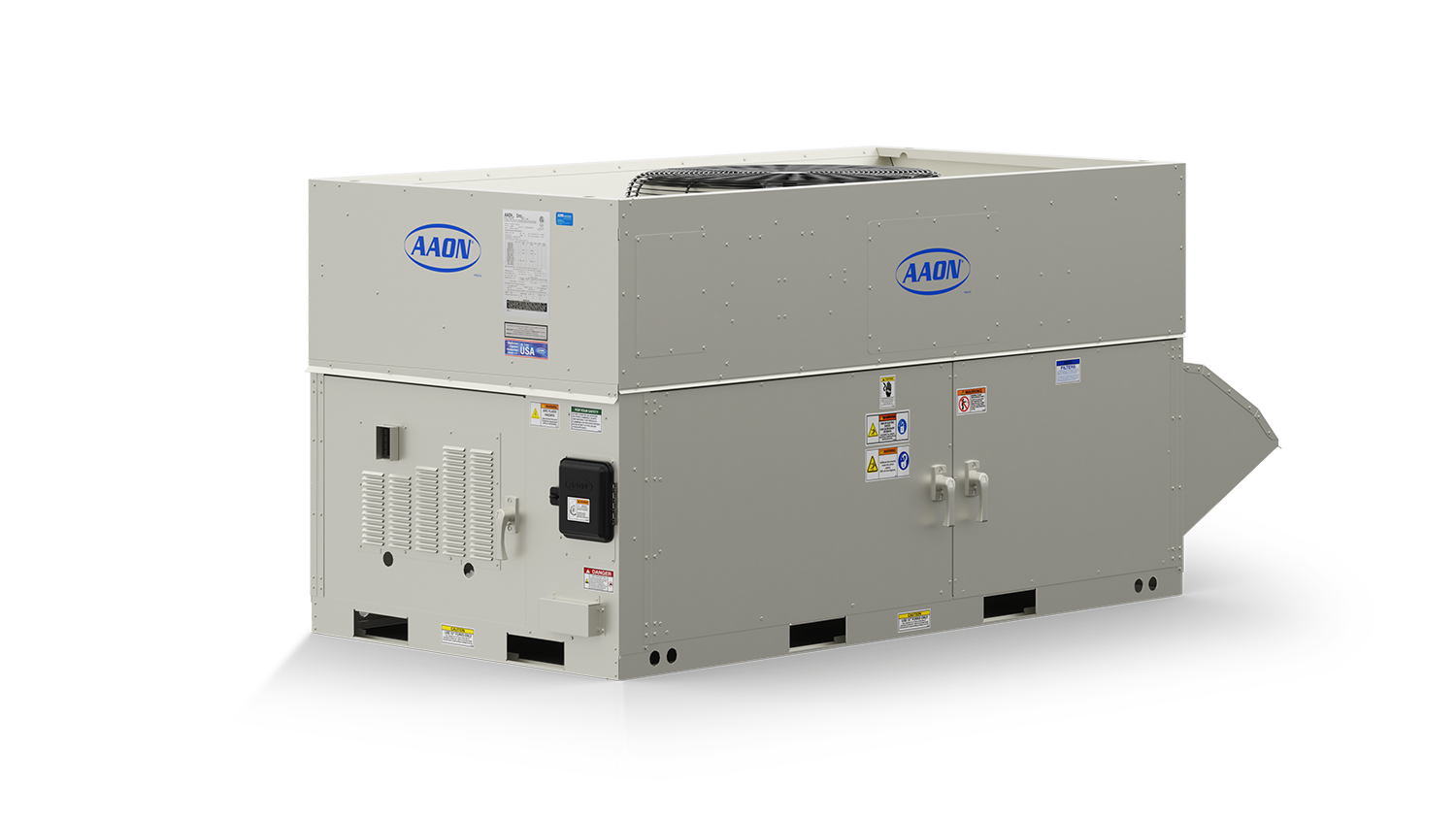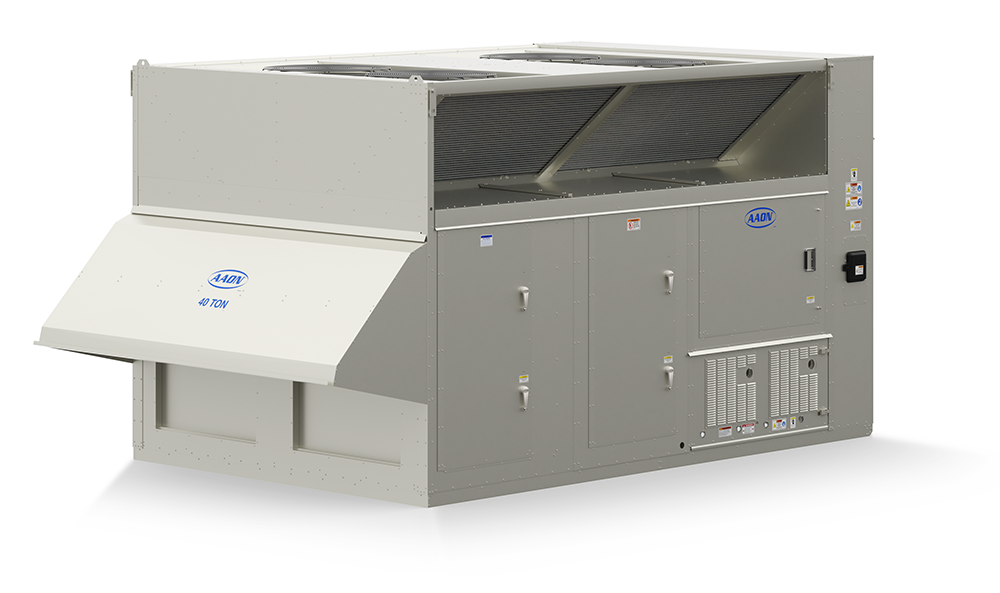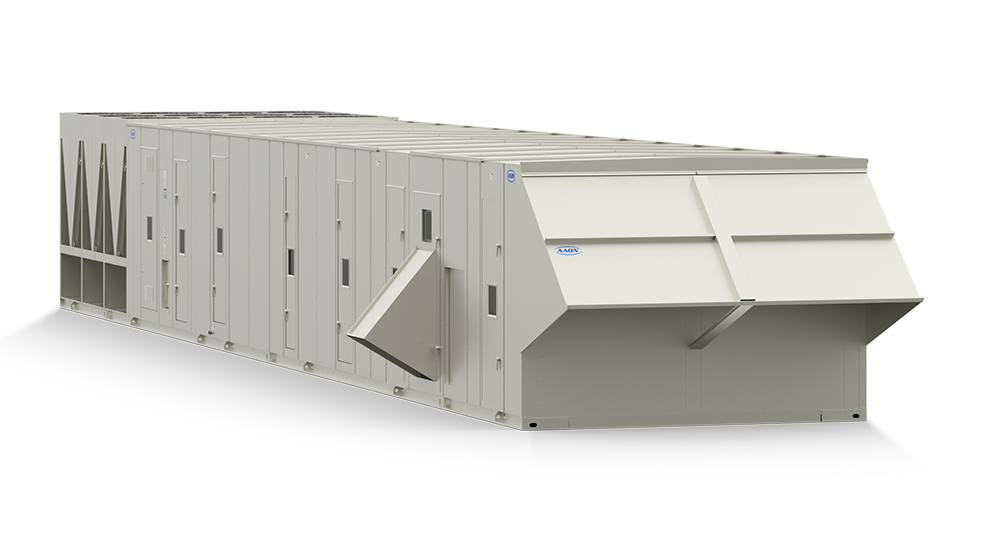What is a Packaged RTU?
A packaged RTU is a self-contained air-conditioner with all the components enclosed in a single cabinet, manufactured to be located outdoors (most commonly on a roof). In addition to cooling, the unit can also provide heating and ventilation. Except for locating the unit thermostat in the space and connecting the fuel source(s) and distribution ductwork, the unit is ready to function when delivered to the building due to its integrated controls.
Packaged RTUs are very common in various commercial and industrial applications because of their convenience, simplicity, and low cost. Buildings with large flat roofs, such as retail stores, schools, office buildings, factories, and warehouses, are especially likely to use packaged RTUs. These units come in sizes ranging from small single-zone units to very large multi-zone units meeting nearly every need. It is not uncommon to see multiple packaged RTUs serving a single building, enabling the dedicated units to address different design conditions and schedules and limiting the risk associated with a single point of failure related to one large unit.
How does a packaged RTU work?
The fact that the packaged RTU is a self-contained piece of equipment distinguishes it from much of the other HVAC equipment in the market. Packaged means that all the components that enable it to function are contained in a single enclosure. The housing, therefore, is important to the unit’s operational performance, longevity, and ease of maintenance. When comparing different manufacturers’ housings, consider construction, insulation, materials used, access doors, and protective weatherized paint.
The functionality of a packaged RTU HVAC system depends on all the components contained in this housing. By definition, all packaged RTUs contain a direct expansion refrigerant cooling cycle for cooling, but they can also provide heating and ventilation, fulfilling the HVAC function. The description below will focus on the traditional definition* of a packaged RTU which includes a direct expansion cooling cycle with an optional heating element that is either an electric resistance coil or natural gas combustion.
Need assistance?
Your local AAON rep is ready to help.
👉 Find a Rep
The direct expansion refrigerant cooling cycle routes refrigerant through four components – the compressor, the condenser coil, the expansion device, and the evaporator coil – connected via refrigerant piping. Each component listed below plays an essential role in removing heat from the building and rejecting it outdoors.
-
Compressor(s) – The compressor compresses the refrigerant, increasing its pressure, which promotes its movement through the piping loop connecting the four components. The compressor is where the work of the DX cycle is performed and the power is consumed.

-
Condenser Coil – The objective of the cooling process is to remove heat from the building. At the condenser coil, heat is rejected to the outdoors. Because the outdoor air temperature is lower than the refrigerant temperature and the resultant coil temperature, it absorbs the heat, cooling and condensing the refrigerant.
-
Condenser Fan – Since the packaged RTU is outside, this heat rejection is conveniently facilitated using a fan to blow outdoor air over the condenser coil, thus removing the heat from the refrigerant.
-
Expansion Device – The refrigerant decreases its pressure and lowers its temperature when passed through the expansion device, allowing it to be effective in the next step of the process.
-
Evaporator Coil – Air from the space is cooled as it is blown through this coil containing cold refrigerant. The refrigerant absorbs heat from this air, cooling and dehumidifying the air stream. This air is delivered to the space, providing the desired air conditioning.
-
Supply Fan – A fan within the packaged RTU extracts warm air from the space (return air), blows it through the evaporator, and distributes the cool, dehumidified air back to the space (supply air). The supply fan selection impacts the unit's efficiency, acoustics, and required maintenance.
-
Duct Connections – Because the unit is located outside the building, ductwork is routed between the unit and the interior space, allowing heated or cooled air to be circulated throughout the building.
HVAC equipment in most applications is designed to address more than just cooling. The items below complement or support the cooling function as well as accommodate the need for air quality, ventilation, and heating.
-
Filters – These air cleaning devices serve two functions: to help keep the evaporator clean and to improve the indoor air quality of the space by reducing airborne particulates. There are many different types of filters. The decision between filters is commonly a balance between budget, particulate removing efficiency, and potential pollutants within the air.
-
Outdoor Intake – Most applications are required to have ventilation to dilute space contaminants. This is accomplished by introducing outdoor air. Since a packaged RTU is located outdoors, it is common for the unit to have an integral outdoor air intake. The unit will then mix outdoor air with return air from the space allowing it to be conditioned and distributed as supply air, eliminating the need for a separate unit and duct system.
-
Exhaust – To properly manage the building pressure, exhaust air is needed to balance the air brought in from outdoors. This, too, can be integrated into the packaged RTU, reducing the need for additional equipment and controls.
-
Controls – The fact that controls are integral to the packaged RTU is a significant advantage to this HVAC solution. This allows the unit to be tested in the factory, decreasing the potential for issues at startup. When the unit arrives on site, the thermostat needs to be installed, power/fuel connections made, and it is ready for operation. Although stand-alone unit control capability is attractive for many applications, the controls can be tied into a building automation system or other system-level control system for centralized management of multiple units.
-
Heating – A packaged rooftop unit can also provide heating to fulfill all HVAC functions. Using the traditional definition* of a packaged RTU, this heating is provided using an electric resistance coil or a natural gas heat exchanger. To optimize natural gas combustion heating efficiency, options such as multi-stage, modulating, or high turn-down ratio should be considered.
*Technically, the classification ‘packaged RTU’ also includes packaged air-source heat pumps (ASHP) because they are also HVAC units contained in a single cabinet and manufactured to be located outdoors. The difference between the traditionally referenced packaged RTU and the packaged air-source heat pump is the heating method.
Packaged RTU Products by AAON
AAON provides some of the highest performing, most energy-efficient packaged RTU equipment. The base unit provide many features that are provided only by upgrade by other manufacturers. AAON offers a solutions-based configurable portfolio of packaged rooftop equipment with the option for many upgrades through a semi-custom design and manufacturing process.
AAON packaged RTUs cover a spectrum of capacities. These units come standard with many premium options and provide the opportunity to upgrade further. Use the links below to explore AAON’s packaged RTU products:



Want to learn more about RTUs? Find your local AAON rep today.
Frequently Asked Questions (FAQs) About Packaged RTUs in HVAC
What does RTU mean in HVAC?
RTU stands for Rooftop Unit, a type of HVAC unit installed on the roof of a building that distributes conditioned air through a ductwork system. A normal packaged rooftop unit always provides cooling using a DX refrigeration cycle and can also offer heating and ventilation.
What is difference between a packaged rooftop unit and a (non-packaged) rooftop unit?
Both a packaged rooftop unit and a (non-packaged) rooftop unit are located outdoors, with the roof being the most frequent position for the unit. The two distinguishing characteristics of a packaged rooftop unit are that it contains all the necessary components to function in a single housing and is always DX cooling. A non-packaged rooftop unit must be connected to other equipment to provide cooling and/or heating.
For example, the non-packaged RTU heating coil could be hot water or steam, requiring a piped connection to a source such as a boiler or heat exchanger. Chilled water could also be used for cooling, requiring external piping tied to a chilled water system. A non-packaged RTU can be used when connections to these alternate heating and cooling systems are preferred. The fact that the non-packaged RTU is not self-contained complicates the installation and requires a more complex control system compared to a packaged RTU. Connections to these other systems compromise the system's dependability due to increased points of failure outside the unit. System efficiency is often reduced when using water for heating or cooling because additional losses are imposed in the generation of hot or chilled water and during the transport of the water via the pump and piping.
How does a packaged RTU work?
A packaged RTU is a self-contained system with all components housed in a single unit.
-
Cooling Mode: The unit removes heat from the building using an evaporator coil located in the air that is distributed to the space. The evaporator is part of the unit’s refrigeration cycle that rejects the space heat to the outdoors, therefore maintaining the space conditions.
-
Heating Mode: The unit generates heat most commonly using gas or electricity and transfers this to air distributed to the space.
-
Ventilation: The unit brings in outside air, combines it with air from the space (return air), filters it, and delivers the conditioned air to the space while maintaining indoor air quality.
What are the main components of a packaged RTU?
Key components of a packaged RTU include:
-
Cooling direct expansion (DX) refrigerant cycle
-
Compressor(s)
-
Evaporator coil
-
Condenser coils
-
Refrigerant and refrigerant piping
-
Expansion device
-
-
Heating element
-
Supply air fan
-
Condenser fan
-
Outside air and exhaust air damper
-
Controls for temperature and airflow regulation
What are the benefits of using a packaged RTU?
-
Space-saving design: Roof installation saves valuable indoor space while the integrated outdoor, exhaust, and relief air openings eliminate louvers, dampers, and additional ductwork and simplifies the controls.
-
Energy efficiency: Many RTUs can be specified with advanced features like variable speed fans and energy recovery systems.
-
Increased reliability, simplified installation, and ease of maintenance: All components are accessible in one unit, simplifying start-up and service.
-
Versatility: Ideal for commercial buildings of various sizes.
-
Reduced refrigerant risk: All refrigerant is located outside the buildin
What is the difference between a packaged RTU and an AHU
-
Packaged RTU (Rooftop Unit): A packaged HVAC unit installed on the roof, designed to handle all HVAC functions in one self-contained unit.
-
AHU (Air Handling Unit): A component of a larger HVAC system, typically located inside the building, that requires additional equipment to provide cooling (i.e., chiller or ACCU) and needs customized controls.
Can packaged RTUs be used in residential applications?
While RTUs are primarily used in commercial and industrial buildings, they can be adapted for large residential properties, especially multi-family housing.
What are the common challenges of using packaged RTUs?
-
Exposure to elements: Installed on the roof, RTUs face weather-related wear and tear.
-
Installation: A roof structurally capable of handling the weight of the RTU.
How do packaged RTUs improve energy efficiency?
Modern packaged RTUs are very efficient in conformance with energy code requirements. Standard 90.1-2022 requires that packaged RTUs have an efficiency greater than 14 IEER. These units can further increase their efficiency by incorporating technologies such as:
-
Variable speed motors
-
High-efficiency compressors
-
Energy recovery wheels
-
Electronically commutated motors (ECM) with backward curved plenum fans
-
Economizer function
How does a packaged RTU differ from a packaged HVAC unit?
A packaged RTU is a specific type of packaged unit installed exterior to the building (most commonly on the roof). While all packaged RTUs are packaged HVAC units, not all packaged units are RTUs.
Why choose AAON for packaged RTU solutions over other HVAC systems?
AAON offers innovative packaged RTU units with advanced performance, durability, and customization options. Their products are designed to meet the needs of modern buildings while reducing energy costs and improving comfort.
